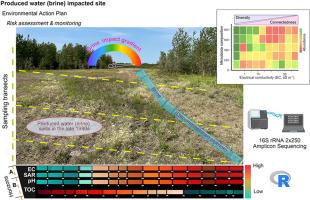盐水诱导的土壤梯度驱动微生物群落组装和生态分配
IF 10.3
1区 农林科学
Q1 SOIL SCIENCE
引用次数: 0
摘要
石油和天然气基础设施释放的盐水(采出水)会改变土壤的理化性质,破坏植被,影响对土壤功能至关重要的微生物群落。我们评估了长期盐水干扰对加拿大阿尔伯塔省北部一个25公顷的北方地区土壤微生物群的影响。土壤,包括表土(A层)和底土(B层)层,沿着4个300米的横断面进行采样,横断面横跨未受干扰的森林到受盐水影响的地区。土壤电导率(EC)从0.1增加到40 dS - m-1,钠吸附比(SAR)从0.1增加到41,pH从4增加到8。微生物多样性随着EC、SAR和pH值的增加而下降,即使在非常强的盐碱地(EC >;16 dS m-1), Shannon多样性指数保持在7以上。大约三分之一的微生物属沿着这些梯度丰富地移动,盐度适应类群丰富,关键的少营养类群减少。我们确定了盐度、碱度和pH梯度的临界点——在EC 1.9和4.2 dS m-1, SAR 3.5和6.4,以及pH ~ 5.5——与群落组成的主要变化相一致。生境分异明显,分别有27%和39%的类群专为未受侵蚀土壤和受盐侵蚀土壤,20%的类群为通才。网络分析显示,受盐水影响的土壤群落聚集更密集,但鲁棒性降低,表明更容易受到环境扰动。这些发现强调了土壤微生物群如何反映盐水干扰的有害影响和适应性反应,强调了它们作为盐影响景观中土壤健康评估的生物指标的价值。本文章由计算机程序翻译,如有差异,请以英文原文为准。

Brine-induced soil gradients drive microbial community assembly and ecological partitioning
Brine (produced water) releases from oil and gas infrastructure alter soil physicochemical properties, disrupt vegetation, and affect microbial communities vital for soil function. We evaluated long-term brine disturbance effects on soil microbiota at a 25-hectare boreal site in northern Alberta, Canada. Soils, including both topsoil (A horizon) and subsoil (B horizon) layers, were sampled along four 300 m transects spanning undisturbed forest to brine-impacted areas. Soil gradients intensified toward brine-impacted zones, with electrical conductivity (EC) increasing from 0.1 to 40 dS m-1, sodium adsorption ratio (SAR) from 0.1 to 41, and pH from 4 to 8. Microbial diversity declined with rising EC, SAR, and pH, however, even in very strongly saline soils (EC > 16 dS m-1), Shannon diversity indices remained above 7. Approximately one-third of the microbial genera shifted in abundance along these gradients, with salinity-adapted taxa enriched and key oligotrophic groups declining. We identified tipping points in salinity, sodicity, and pH gradients—at EC 1.9 and 4.2 dS m-1, SAR 3.5 and 6.4, and pH ∼5.5—coinciding with major shifts in community composition. Habitat partitioning was evident, with 27% and 39% of taxa specialized to unimpacted and brine-impacted soils, respectively, while 20% were generalists. Network analysis revealed denser community assembly but reduced robustness in brine-impacted soils, indicating greater vulnerability to environmental perturbations. These findings highlight how soil microbiota reflect both the detrimental effects of brine disturbance and adaptive responses, underscoring their value as bioindicators for soil health assessment in salt-impacted landscapes.
求助全文
通过发布文献求助,成功后即可免费获取论文全文。
去求助
来源期刊

Soil Biology & Biochemistry
农林科学-土壤科学
CiteScore
16.90
自引率
9.30%
发文量
312
审稿时长
49 days
期刊介绍:
Soil Biology & Biochemistry publishes original research articles of international significance focusing on biological processes in soil and their applications to soil and environmental quality. Major topics include the ecology and biochemical processes of soil organisms, their effects on the environment, and interactions with plants. The journal also welcomes state-of-the-art reviews and discussions on contemporary research in soil biology and biochemistry.
 求助内容:
求助内容: 应助结果提醒方式:
应助结果提醒方式:


